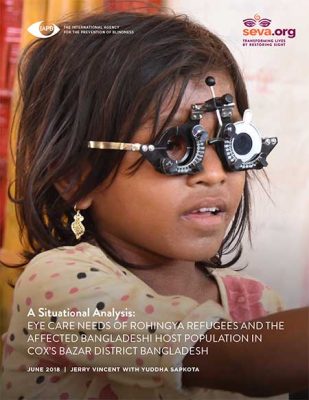Join a powerful, unprecedented alliance for better eye health for all.
Join IAPB-
Choose an alternate language here
The Seva Foundation, an international eye health and blindness-prevention organization, recently released a new report to assess the eye care needs of the one million Rohingya people living in refugee camps in Bangladesh. “A Situational Analysis: Eye Care Needs of Rohingya Refugees and the Affected Bangladeshi Host Population in Cox’s Bazar District Bangladesh” provides a snapshot of the critical eye care needs in this region. Key international non-governmental organizations (INGOs) have established an eye care working group to coordinate sight-related medical response for these refugees. The report was completed in partnership with the International Agency for the Prevention of Blindness.
In the face of what the United Nations has referred to as ethnic cleansing, hundreds of thousands of Rohingyas have fled Myanmar. Approximately one million people currently live in refugee camps located in Cox’s Bazar District, Bangladesh.
Displaced populations bring their health care needs with them, including vision problems like cataract and low vision. Substandard living conditions in refugee camps create additional threats to eye health.
“Providing eye care is one of the most effective ways to lift people out of poverty,” said Kate Moynihan, Executive Director of the Seva Foundation. “The Rohingya people are facing multiple severe threats to their health and dignity. Addressing their eye health needs will help this embattled population reach toward independence. A relatively modest strategic investment into eye care systems in Cox’s Bazar would make it possible for those who suffer from preventable blindness and low vision to care for themselves and gain access to economic opportunity, including the ability to access education for refugee children.”
According to the report, after addressing acute life-saving needs, the Rohingya refugee camps must prioritize integrating eye care as a critical component of primary health care. The report highlights several widespread eye care issues affecting the refugee population:

“The situation in Cox’s Bazaar is distressing; the conditions fluid and the availability of resources is very limited. And yet, we have a vital role in ensuring that these populations have access to basic health services, including eye care,” added Yuddha Sapkota, IAPB South-East Asia Regional Coordinator.
“I do hope that we will be able to respond with adequate strength. IAPB is keen to play a role in formulating a solid and dependable response there.”
To arrange an interview with those knowledgeable about the report’s findings, contact Nina Erlich-Williams at [email protected] or 510-336-9566.